- home
- BAKERECIPES
BakeRecipes
Bringing real baking into your home with deliciously simple recipes.
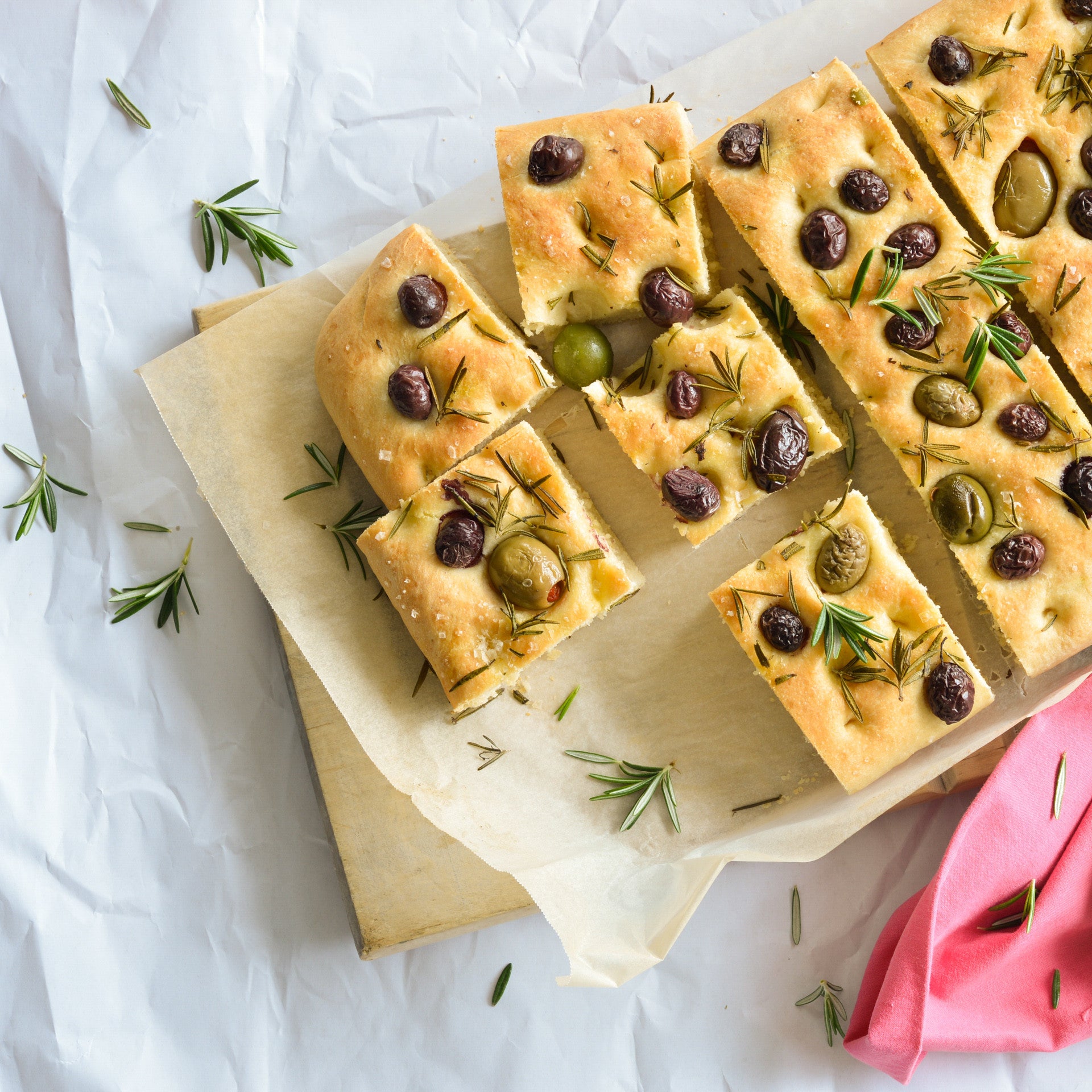
Prep 25min (+ 1hr 30min proving time)Bake 25minMakes 8-10 serves
Predecessor to the modern pizza, focaccia is a simple Italian flatbread that was associated with Christmas Eve and Epiphany for many centuries. This savoury version, studded with fragrant rosemary and mixed olives, makes a fabulous accompaniment to a cheese board, picnic spread or soup.
Ingredients
- 600g (4 cups) strong bread or pizza flour, plus extra to dust
- 3 teaspoons instant dried yeast
- 2 teaspoons salt
- 330ml (1⅓ cups) luke warm water
- 2 tablespoons olive oil, plus extra to grease and 2 tbsp to drizzle
- 150g mixed olives
- 2 tablespoons fresh rosemary leaves
- sea salt flakes, to sprinkle
Method
- To make the dough, combine the flour, yeast and salt in a large bowl and make a well in the centre. Combine the water and oil, add to the flour mixture and use a wooden spoon and then your hands to mix to a soft dough.
- Turn the dough onto a lightly floured surface and knead for 5-8 minutes or until it is smooth and elastic and springs back when you push your finger into it. Place the dough in an oiled bowl, turning it to coat lightly with the oil. Cover with plastic wrap and place in a warm, draught-free place for 1 hour or until doubled in size.
- Line a large baking tray with baking paper.
- Knock back the dough by punching it in the centre with your fist. Turn the dough onto the lined tray and use your hands to press down on it, and to pull and stretch it to form a rough rectangle about 20 cm x 30 cm and 1.5 cm thick. Use your fingertips to press into the surface of the dough to form dimples.
- Press the olives and rosemary into the surface flatbread. Drizzle with the extra olive oil and then sprinkle with the salt.
- Set aside in a warm draught-free place for 30 minutes or until risen slightly.
- Preheat the oven to 220°C (200°C fan-forced).
- Bake in the centre of the preheated oven for 25 minutes or until golden and cooked through. Serve warm or at room temperature.
Baker's Tips
- This focaccia is best eaten the day it is baked.
This recipe is from Anneka's SBS Food online column, Bakeproof: Yeast-leavened Flatbreads. CLICK HERE for more Bakeproof recipes.
Photography by Alan Benson.
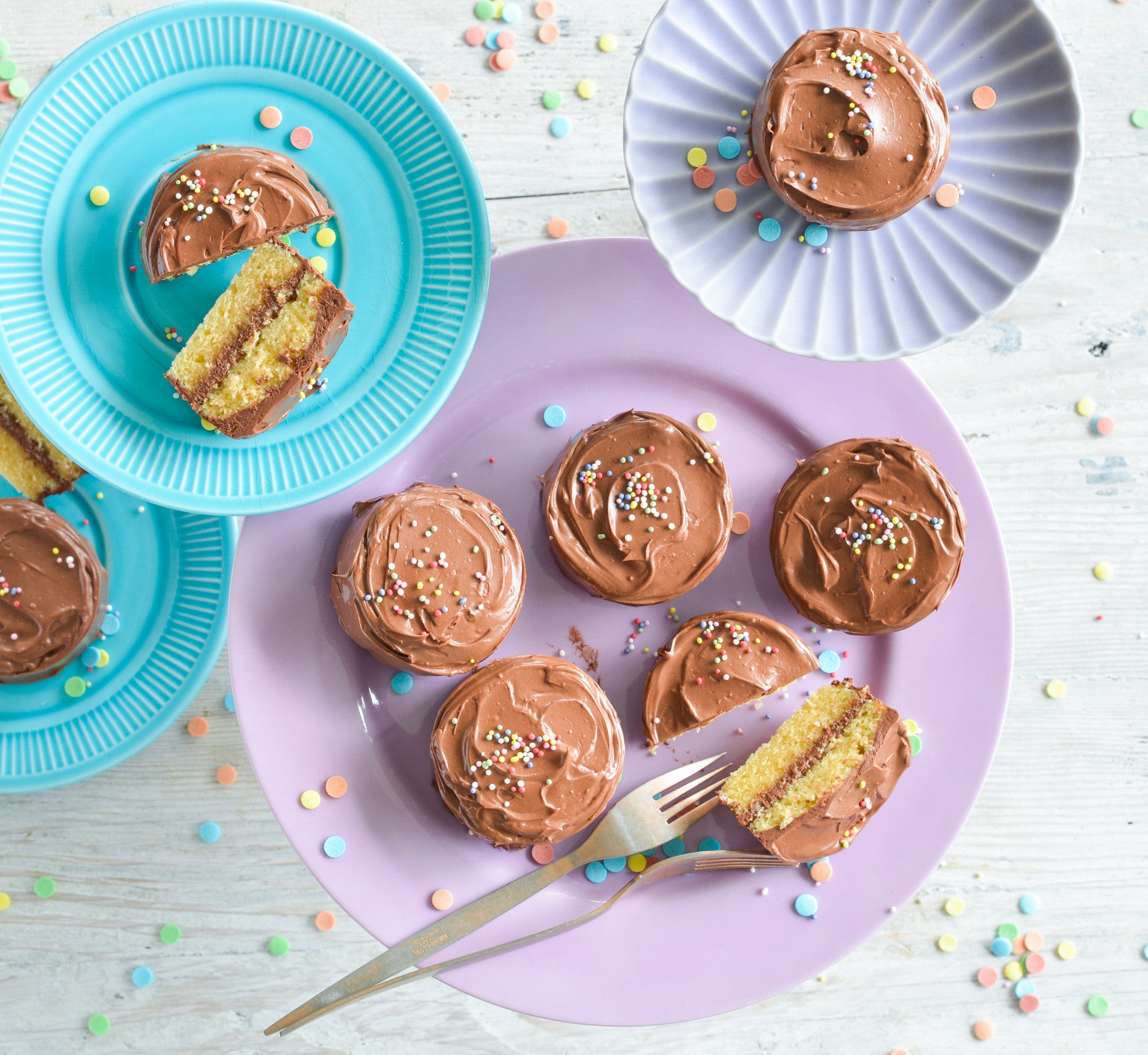
Prep 40min (+30min cooling time)
Bake 25minMakes about 10
Everyone needs a good classic yellow cake in their repertoire and this one, made as cute individual cakes with a rich, velvety fudge frosting, is the one to add. Have some fun with the decorations – there are so many edible sprinkles to choose from you may want to give each individual cake its own unique identity.
Ingredients
- 20g butter, melted and combined with 1 teaspoon plain flour, to grease
- 125g salted butter, softened
- 165g (¾ cup) caster sugar
- 2 teaspoon natural vanilla essence or extract
- 1 egg, at room temperature
- 2 egg yolks, at room temperature
- 225g (1½ cups) plain flour
- 2½ teaspoon baking powder
- 125ml (½ cup) buttermilk or milk
- Sprinkles of your choice, to decorate
Chocolate fudge frosting
- 1 tablespoon cocoa powder, sifted
- 1 tablespoon hot water
- 185g salted butter, softened
- 60g (½ cup) icing sugar mixture, sifted
- 1 teaspoon natural vanilla essence or extract
- 250g good-quality dark chocolate (54% cocoa), melted and cooled
Method
- Preheat the oven to 190°C (170°C fan-forced). Brush a 12-hole 80ml (⅓ cup) muffin pan with the melted butter mixture to grease.
- Use an electric mixer with a paddle attachment to beat the butter, sugar and vanilla until very pale and creamy. Add the egg and beat until well combined. Beat in the egg yolks, scraping down the sides of the bowl when necessary, until well combined and the mixture is pale and creamy.
- Sift together the flour and baking powder. With the motor running on lowest possible speed, add half the flour mixture and beat until just combined. Add the buttermilk or milk and beat on low until just combined. Add the remaining flour and beat until just combined.
- Divide the mixture evenly between the muffin holes and use the back of a spoon to smooth the tops. Bake for 25 minutes or until golden and cooked when tested with a skewer inserted in the centre. Stand in the tin for 5 minutes before transferring to a wire rack to cool.
- Meanwhile, to make the Chocolate Fudge Frosting, combine the cocoa powder and water in a small dish and stir until smooth and a paste forms. Set aside until cooled to room temperature. Use an electric mixer to beat the butter and icing sugar until very pale and creamy, scraping down the sides of the bowl when necessary. Gradually beat in the cooled chocolate and cocoa mixture until smooth and well combined.
- Cut each of the cooled cakes in half horizontally. Use a palette knife or the back of a teaspoon to spread a little of the chocolate fudge frosting over the bottom half of a cake and sandwich with the top half. Spread the top and sides of the cake generously with some of the remaining frosting, swirling on top and making an indent in the centre. Decorate with sprinkles. Repeat with the remaining cakes, frosting and sprinkles.
Baker's Tips
- These cakes will keep in an airtight container at room temperature for up to 2 days.
This recipe is from Anneka's SBS Food online column, Bakeproof: Little Cakes. CLICK HERE for more Bakeproof recipes.
Photography by Alan Benson.
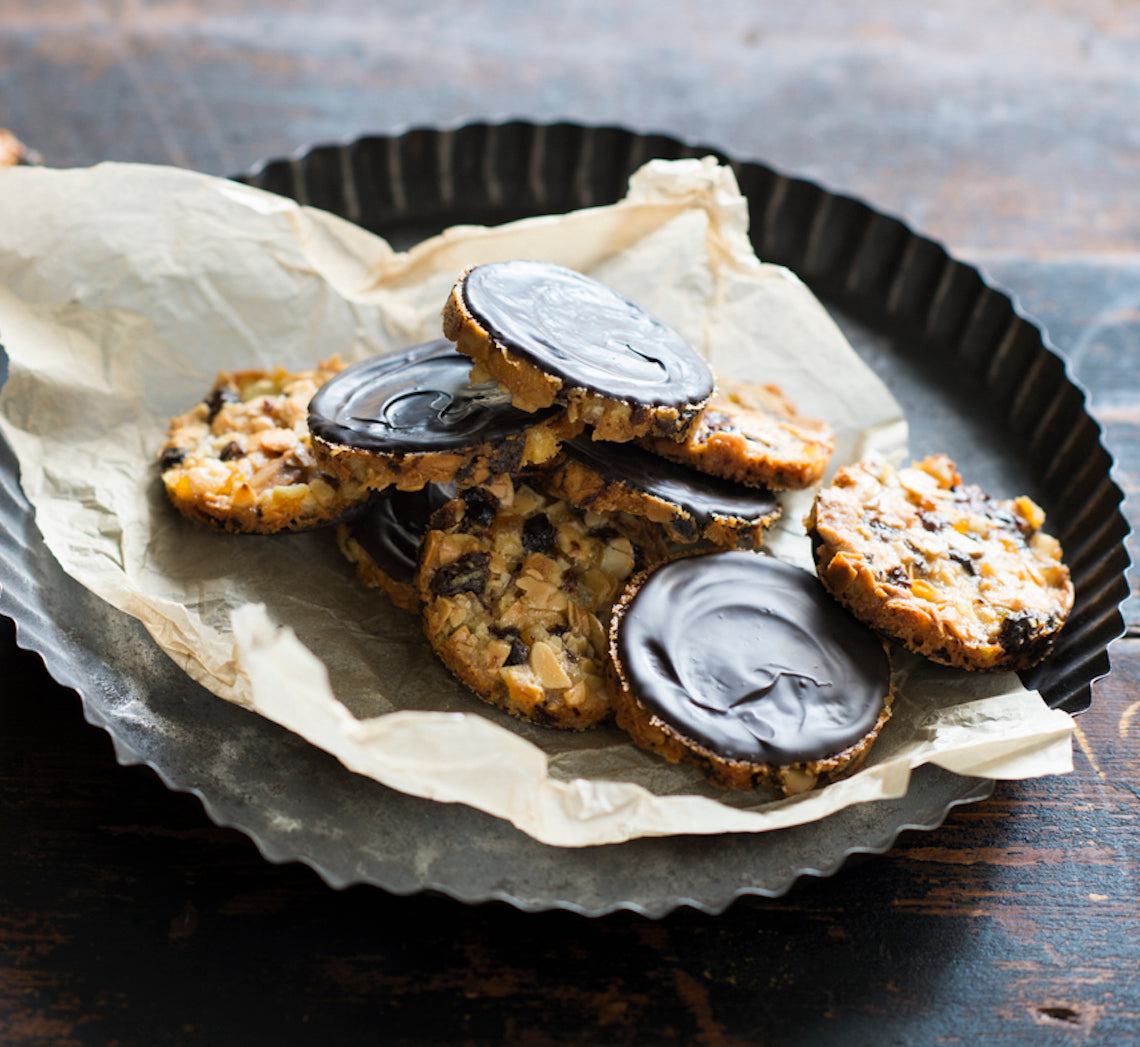
Prep 20minBake 25min(per batch)Makes about 24
Often attributed to the Italians, it is believed that Florentines were actually created in the royal French kitchens in the late 1600s in honour of their Tuscan in-laws, hence their name. Admittedly a little confusing for us, but incredibly flattering for the in-laws!
Ingredients
Melted butter, to grease
200g flaked almonds
150g sour dried cherries, finely chopped
150g candied orange rind, finely chopped
75g (½ cup) plain flour
75g butter, cubed
75g (⅓ cup) caster sugar
115g (80ml/⅓ cup) honey
200g good-quality dark chocolate (70% cocoa), melted and cooled (see Baker's Tips)
Method
- Preheat oven to 160°C (140°C fan-forced).
- Line an oven tray with non-stick baking paper. Brush the inside of six 7.5cm metal egg rings (see Baker's Tips) with a little melted butter to grease and place on the lined oven tray.
- Combine the flaked almonds, dried cherries, candied orange rind and flour in a large bowl and stir to combine evenly. Combine the butter, sugar and honey in a small saucepan and stir over medium heat until the butter just melts and the mixture is well combined. Add to the almond mixture and stir gently with a large metal spoon or spatula until evenly combined.
- Spoon 1½ tablespoons of the mixture into an egg ring to fill half way and use the back of a metal spoon to spread, leaving it a little uneven if you want. Repeat with more mixture and the remaining five egg rings.
- Bake in preheated oven for 25 minutes or until golden and cooked through. Remove from the oven and cool on the trays for 5 minutes before removing the egg rings. Grease the egg rings again with a little more melted butter and repeat with the remaining mixture in three more batches.
- Use a palette knife or the back of a teaspoon to spread a generous amount of melted chocolate over the underside of a florentine to cover. Place on a wire rack, chocolate side up and set aside for 1 hour or until the chocolate sets. Repeat with the remaining cooled florentines.
Baker's Tips
- The longer the chocolate cools the thicker it will become and the more defined the 'swirls' of chocolate will be.
- Non-stick egg rings are perfect to use to make these florentines, but they will still need to be greased.
- These florentines will keep in an airtight container or jar in a cool dark place for up to 2 weeks.
This recipe is from Anneka's SBS Food online column, Bakeproof: Gifts from the Kitchen. CLICK HERE for more Bakeproof recipes.
Photography by Alan Benson.
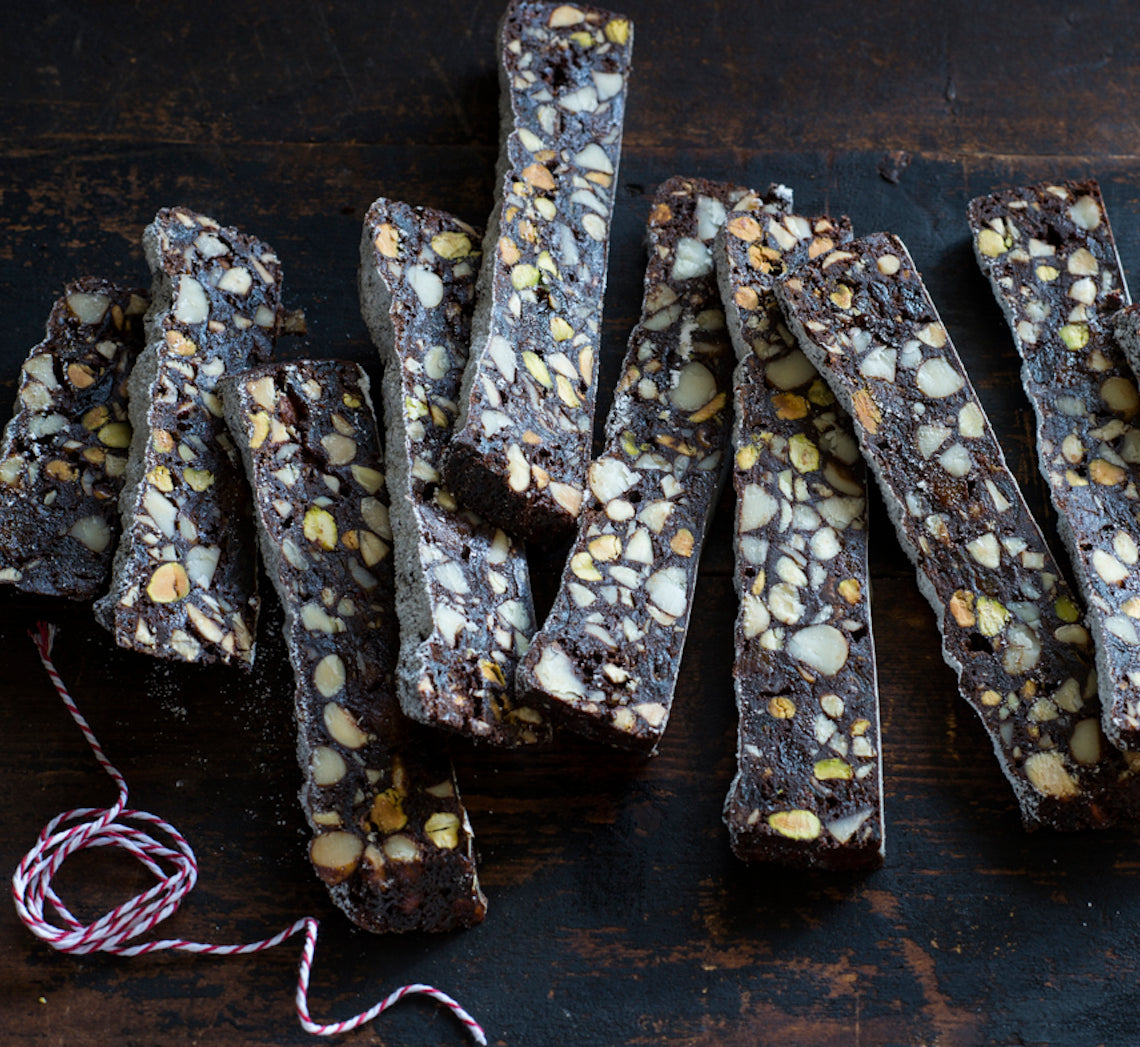
Prep 30min (+2hr cooling time)Bake 40-45minMakes about 20-24 pieces
Hailing from Siena in the Tuscan region of Italy, panforte (‘strong bread’ when translated to English) is a delectable combination of dried fruits, nuts, spices, honey and, if you are lucky, chocolate. It is believed to date back to the 13th Century and was originally a form of tax paid to a local monastery. Like many traditional recipes, there are many variations with each often being a well-guarded family recipe – however I will share this one with you!
Ingredients
- Melted butter, to grease
- 2 sheets confectioner's rice paper (see Baker's Tips)
- 75g (½ cup/2¾oz) plain flour
- 40g (⅓ cup/1½oz) cocoa powder
- 1 teaspoon ground cinnamon
- ½ teaspoon freshly ground black pepper
- 70g (½ cup/2½oz) dried pitted dates, coarsely chopped
- 80g (½ cup/2¾oz) prunes, coarsely chopped
- 80g (2¾oz) glace apricots, chopped
- 155g (1 cup/5½oz) unsalted roasted macadamias, coarsely chopped
- 160g (1 cup/5¾oz) blanched almonds, coarsely chopped
- 70g (½ cup/2½oz) unsalted pistachio kernels
- 100g (3½oz) good-quality dark chocolate, chopped
- 1½ tablespoon finely grated orange rind
- 175g (½ cup/6¼oz) honey
- 110g (½ cup/4oz) caster sugar
- 2 tablespoon water
- 1 teaspoon natural vanilla essence or extract
- Icing sugar or extra cocoa powder, to dust
Method
- Preheat oven to 170°C/340°F (150°C/300°F fan-forced).
- Brush a shallow round 20cm/8in (base measurement) tin with melted butter to grease and then line the base with a circle of rice paper, cutting the sheets to fit. Line the sides with a strip of non-stick baking paper.
- Sift the flour, cocoa and spices into a large bowl, then stir in the fruit, nuts, chocolate and orange rind. Set the bowl on a folded tea towel (see Baker's Tips).
- Put the honey, sugar and water in a small saucepan. Stir over low heat, without boiling, until the sugar dissolves. Bring to the boil and simmer, uncovered and without stirring, for 5 minutes. Immediately pour the hot syrup and vanilla over the fruit and nut mixture and, working quickly, stir with a wooden spoon until well combined. Press mixture firmly and evenly into prepared tin.
- Bake for 40-45 minutes or until firm to touch in the centre. Cool in the pan sitting on a wire rack (this will take about 2 hours).
- Remove from pan and dust liberally with icing sugar or cocoa. Serve in thin slices or wedges.
Baker's Tips
- Confectioner's rice paper sheets are available from Asian grocers, delicatessens and specialty food stores. Don't confuse it with Asian rice paper, used to make rice paper rolls.
- Before adding the hot syrup to the fruit and nut mixture, place a tea towel under the bowl to stop it from slipping when mixing.
- To make individual panforte, grease eight 8cm (base diameter) loose-bottomed tart tins with oil spray or melted butter and line the bases with a circle of edible rice paper. Divide the mixture among the tins and press down firmly. Bake for 25-30 minutes.
- This panforte will keep wrapped well in plastic wrap at room temperature in a cool spot for up to 1 month.
This recipe is from Anneka's SBS Food online column, Bakeproof: Gifts from the Kitchen.
CLICK HERE for more Bakeproof recipes.
Photography by Alan Benson.
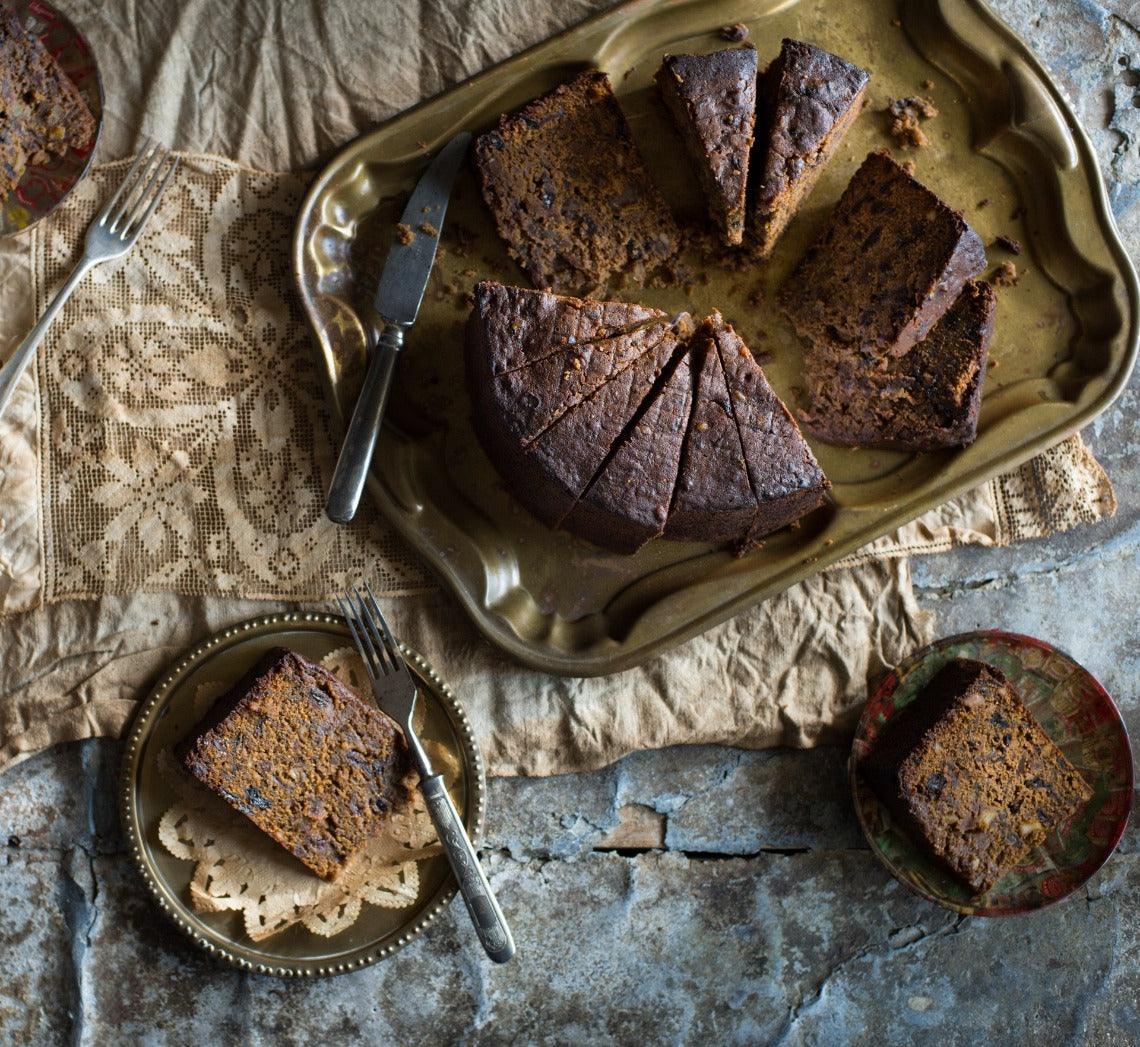
Prep 30min (+3days soaking and overnight cooling time)Bake 2hr 30minMakes 20 serves
This is Colombia’s version of a rich fruit cake. Dense with prunes, raisins and figs, generously spiked with both rum and port, and cleverly flavoured with aromatic spices, it is hard to stop at one piece. Traditionally dulce quemado (sweet burnt brown sugar), either homemade or bought, is used to sweeten this cake, but molasses makes a perfectly acceptable substitute as I've done in this recipe.
You will need to start this cake at least 6 days before baking.
Ingredients
200g (1 cup) pitted prunes
170g (1 cup) seedless raisins
80ml (⅓ cup) port, plus 80ml (⅓ cup) extra
60ml (¼ cup) dark rum, plus 60ml (¼ cup) extra
80g (½ cup) blanched almonds
50g (½ cup) pecans
melted butter, to grease
200g (1 cup) tenderised figs or drained figs in syrup (see Baker's Tips), finely chopped
250g butter, at room temperature
275g (1¼ cups) caster sugar
2 teaspoons vanilla essence
5 eggs, at room temperature
250g (1⅔ cups) plain flour
1 teaspoon baking powder
½ teaspoon ground cinnamon
¼ teaspoon ground nutmeg
¼ teaspoon ground cloves
¼ teaspoon salt
2 tablespoons molasses (see Baker's Tips)
Method
- Process the prunes and raisins in a food processor using the pulse button until chopped. Transfer to a bowl and stir in the port and rum. Cover and set aside for at least 3 days to soak (see Baker's Tips).
- Preheat oven to 170°C (150°C fan-forced). Grease a deep round 20 cm cake tin with melted butter and line the base and sides with non-stick baking paper.
- Process the almonds and pecans in a food processor until chopped. Add to the prune mixture with the figs and stir to combine evenly. Use an electric mixer to beat the butter, sugar and vanilla until pale and creamy, scraping down the sides of the bowl when necessary. Add the eggs one at a time, beating well after each addition.
- Sift together the flour, baking powder, spices and salt. Add to the butter mixture and beat on lowest possible speed until just combined. Add the molasses and beat on low until just combined. Use a wooden spoon to stir in the fruit and nut mixture until evenly combined.
- Spoon the mixture into the prepared tin, pressing well into the corners, and then smooth the surface with the back of a spoon. Cover the tin with a piece of foil and then bake in preheated oven for 2 hours and 25 minutes to 2 hours and 35 minutes or until cooked when tested with a skewer.
- Remove from the oven and stand in the tin for 10 minutes before turning onto a wire rack. Combine the extra port and rum and brush over the top of the cake. Wrap the warm cake in plastic wrap and then foil and set aside overnight to cool.
- Store for at least 3 days at room temperature before serving.
Baker's Tips
- The prunes and raisins require 3 days or more to soak, so you could start the soaking one weekend and cook the cake the next.
- Dulce quemado (sweet burnt brown sugar) is traditionally used in this cake and is considered more important than the alcohol or spices to add flavour. It not only adds a rich colour but also a sweet/bitter flavour to the cake. It can be home made or bought, although outside of Latin America it can be hard to track down. Molasses makes a good substitute.
- This cake will keep wrapped well in plastic wrap and sealed in an airtight container in a cool spot, but not in the fridge, for up to 3 months.
- To make the lattice pattern on the top of the cake as we have, turn the cake upside down on a cake rack after cooling and press down firmly. Turn the cake 90 degrees and press again.
This recipe is from Anneka's SBS Food online column, Bakeproof: Latin American Cakes.
CLICK HERE for more Bakeproof recipes.
Photography by Alan Benson.

Prep 40minBake 20-25minMakes about 18
These melt-in-the-mouth buttery biscuits, sandwiched with a creamy, sweet buttercream, are an all-time favourite. This version has the addition of orange zest in the filling, which adds a subtle citrus tang. They're the perfect accompaniment to a cuppa.
Ingredients
250g (9oz) salted butter, cubed, softened
110g (⅔ cup/4oz) icing sugar
1½ teaspoons natural vanilla essence or extract
250g (1⅔ cups/9oz) plain flour
60g (½ cup/2oz) cornflour (see Baker's Tips)
Orange buttercream filling
60g (2oz) salted butter, softened
1 orange, zest finely grated
125g (1 cup/4½oz) icing sugar, sifted
Method
- Preheat the oven to 160°C/315°C (140C/285°F fan-forced). Line 2 large baking trays with baking paper.
- Use an electric mixer on medium to beat the butter, icing sugar and vanilla until pale and creamy, scraping down the side of the bowl when necessary.
- Sift the flour and cornflour together over the butter mixture. Mix on low speed (or use your hands to mix) until just combined and a soft dough forms.
- Use lightly floured hands to roll heaped teaspoonfuls of the mixture into balls and place on the lined trays, about 5cm/2in apart (you should have about 36 balls). Dip a fork in flour and use it to flatten the balls to about 1cm/½in thick and 4cm/1½in in diameter.
- Bake in preheated oven for 20-25 minutes, swapping the trays after 8 minutes, or until the biscuits are a pale golden colour. Remove from the oven and cool on the trays.
- While the biscuits are cooling, make the orange buttercream filling. Put the butter and orange zest in a small mixing bowl and use an electric mixer to beat on medium speed until pale and creamy. Add the icing sugar and beat on low speed, scraping down the side of the bowl when necessary, until well combined and smooth.
- To join the biscuits, spread a little buttercream on the base of a cooled biscuit and sandwich with another biscuit. Repeat with the remaining biscuits and filling.
Baker's Tips
- The cornflour can be replaced with custard powder for a more intense vanilla/custardy flavour.
- These biscuits will keep in an airtight jar or container in a cool place (not the fridge) for up to 4 days.
Variations
Coffee Melting Moments – Replace the orange zest in the filling with 1 teaspoon instant coffee granules dissolved in 1 teaspoon boiling water, cooled before using.
Lemon Melting Moments – Replace the orange zest in the filling with the finely grated zest of 1 large lemon.
Passionfruit Melting Moments – Replace the orange zest in the filling with 1 tablespoon passionfruit pulp.
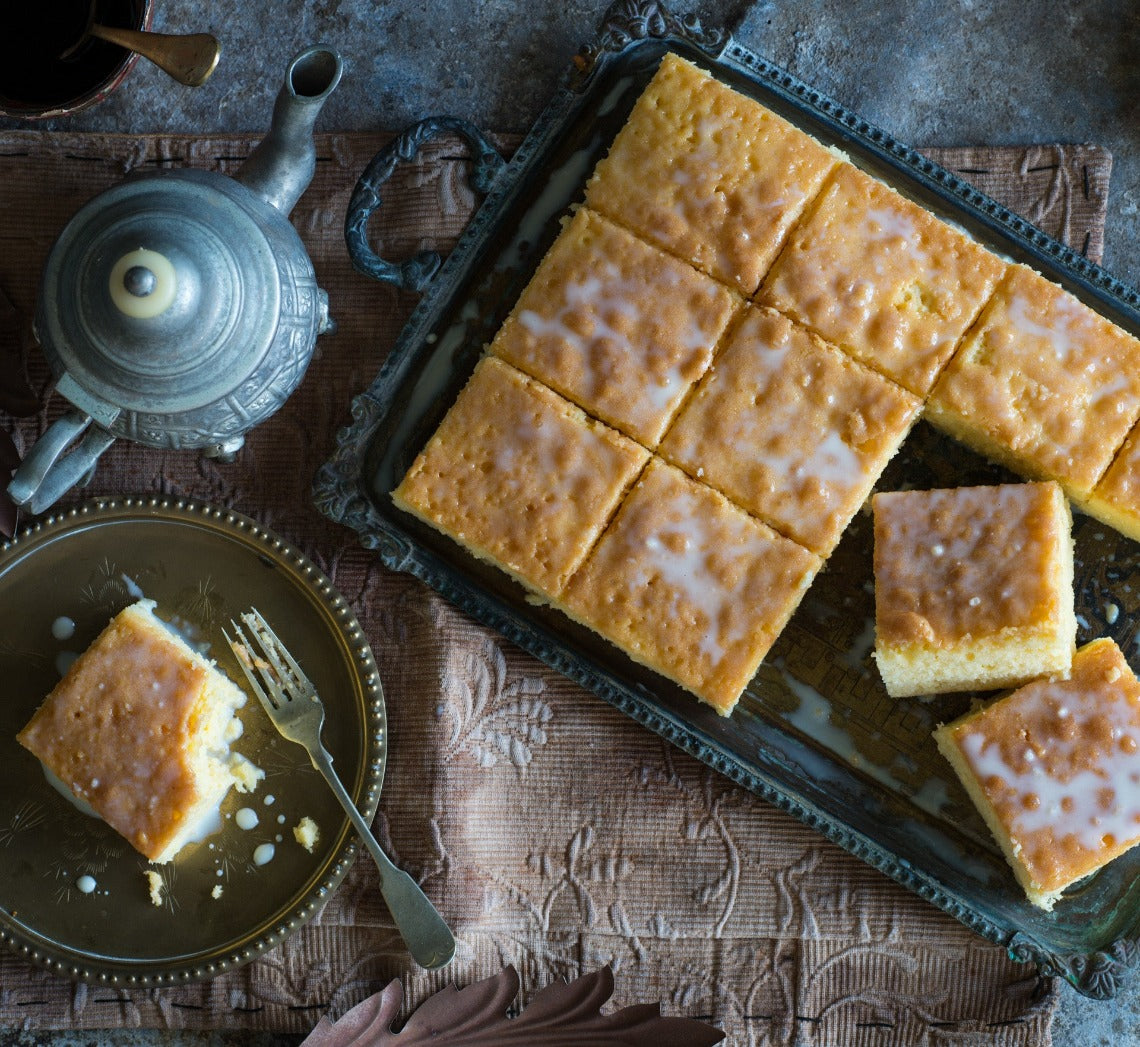
Prep 30min (+3hr chilling and 2hr cooling time)Bake 35minMakes 12 serves
Immensely well-loved in Latin America, a recipe for this wonderfully milky cake appeared on the label of Nestle’s sweetened condensed milk cans in the 1940s, possible explaining why its popularity has spread so widely in this part of the world.
Ingredients
Sponge Cake
5 eggs, at room temperature
220g (1 cup/7¾oz) caster sugar
125g (4½oz) butter, melted
150g (1 cup/5¼oz) plain flour
75g (½ cup/2¾oz) self-raising flour
1 teaspoon natural vanilla essence or extract
Milk Syrup
395g tin sweetened condensed milk
150ml evaporated milk
250ml (1 cup) full-cream milk
Method
- Preheat the oven to 180°C/350°F (160°C/315°F fan-forced). Grease a 20cm x 30cm (8in x 12in), base measurement, shallow cake tin or lamington pan and line the base and two longs sides with one piece of non-stick baking paper.
- Use an electric mixer with a whisk attachment to whisk the eggs on high speed until combined. Gradually add the sugar, about 55g (¼ cup/2oz) at a time, whisking well after each addition. Once all the sugar has been added, whisk on high for a further 4 minutes or until the mixture is very thick and a ribbon trail forms when the whisk is lifted. Reduce the mixer speed to low and gradually add the melted butter, whisking until just incorporated. Sift together the plain and self-raising flours. Add to the egg mixture in three separate batches, whisking on low speed between each addition until just combined and scraping the bottom of the bowl when necessary to make sure all the flour is incorporated.
- Pour batter into the prepared tin and gently tap it on the bench three times to remove any excess air bubbles. Bake in preheated oven for 30-35 minutes or until the cake is firm when touched in the centre and a skewer inserted in the centre comes out clean.
- Just before the sponge is ready, make the Milk Syrup by combining the sweetened condensed milk, evaporated milk and milk in and bowl and stirring with a balloon whisk until well combined. Transfer to a jug.
- Remove the sponge from the oven and stand in the tin for 3 minutes before inverting onto a tray with a lip. Use a skewer to prick holes all over the surface of the cake and all the way through. Pour the milk mixture evenly and slowly over the warm cake, allowing it to soak it up. Stand at room temperature until cool (this will take about 2 hours) and then refrigerate, uncovered, for 3 hours or overnight. Cut into pieces to serve (see Baker's Tips).
Baker's Tips
- For an extra rich cake you can top it with 375 ml (1½ cups) thickened cream that has been whisked to soft peaks with 2 tablespoons of sifted icing sugar and 1 teaspoon of natural vanilla essence or extract before serving.
- This cake will keep covered in the fridge for up to 3 days. Serve at room temperature.
This recipe is from Anneka's SBS Food online column, Bakeproof: Latin American Cakes.
CLICK HERE for more Bakeproof recipes.
Photography by Alan Benson.
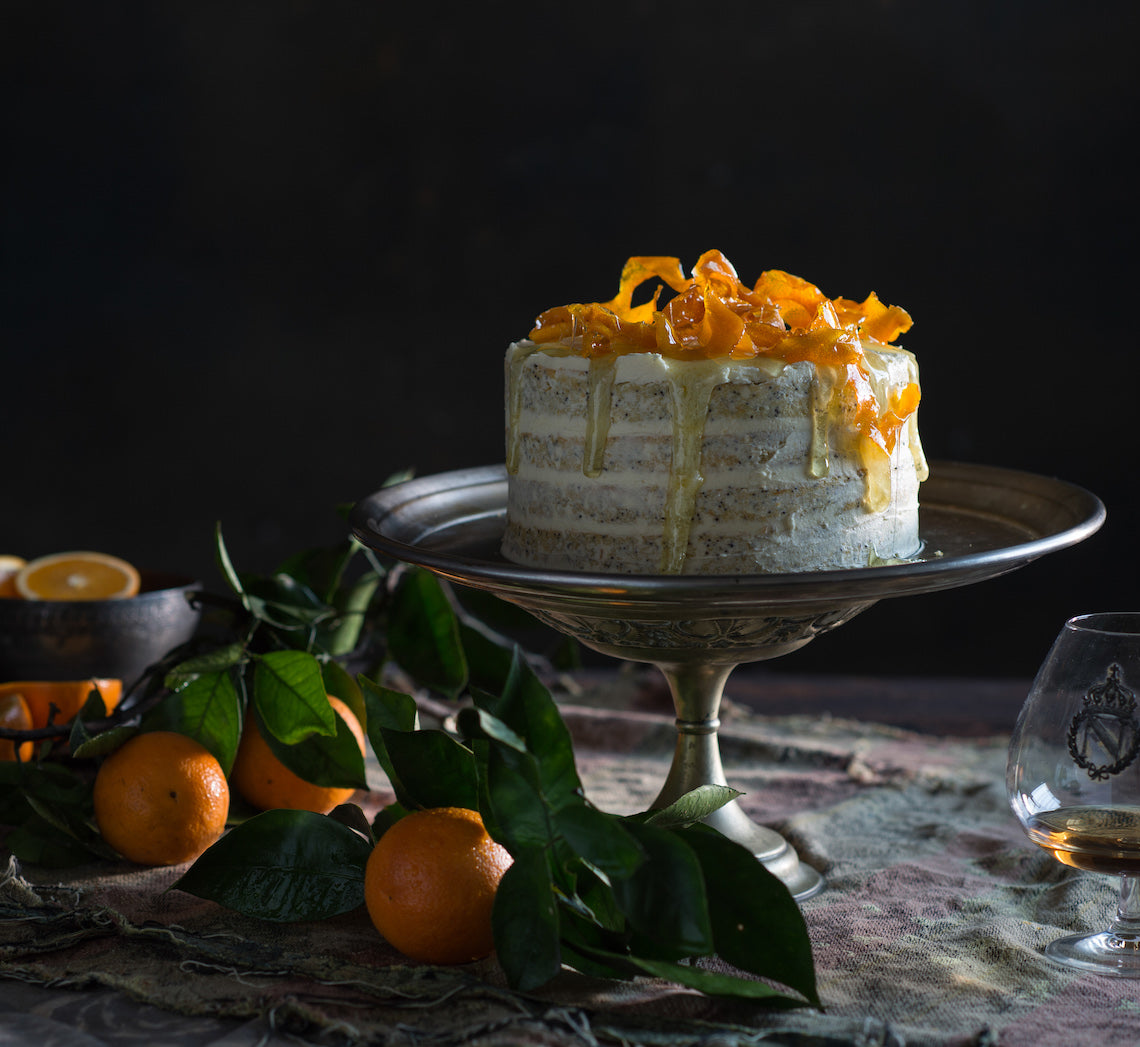
Prep 45min (+30min cooling time per batch)Bake 45minMakes 12-14 serves
This pretty cake, with its heavenly orange blossom-scented frosting, is currently one of my favourite 'special occasion' cakes – particularly for birthday celebrations. The cake layers are baked in two batches but if you are lucky enough to have four cake pans that can fit in your oven all at once, feel free to make the mixture in one lot and bake them all together.
Ingredients
Melted butter, to grease
Orange poppy seed cake layers
3 oranges
3 tablespoons poppy seeds
125g (½ cup) sour cream
250g butter, cubed, at room temperature
300g (1⅓ cups) caster sugar
4 eggs
350g (2⅓ cups) plain flour
3 teaspoons baking powder
Candied orange rind
3 oranges
220g (1 cup) caster sugar
250ml (1 cup) water
Orange blossom water buttercream
250g butter, at room temperature
375g (3 cups) icing sugar, sifted
3-4 teaspoons orange blossom water (or to taste)
Method
- To make the cake layers, preheat the oven to 180°C. Grease two shallow 20cm (base measurement) round cake tins with melted butter and line the bases with rounds of non-stick baking paper.
- Finely grate the rind from the oranges and set aside. Juice the fruit and measure 125ml (½ cup), reserving the rest for another use. Divide the juice evenly between two medium bowls. Add half the poppy seeds and half the sour cream to each. Set aside.
- Use an electric mixer to beat 125g of the butter, 150g of the sugar and half the orange rind until pale and creamy. Add 2 of the eggs, one at a time and beating well after each addition. Sift together 175g of the flour and 1½ teaspoon of the baking powder. Fold half the flour mixture through the butter mixture until just combined. Fold through one quantity of the poppy seed mixture and then the remaining flour mixture until just combined.
- Divide the cake mixture evenly between the prepared cake tins and use the back of a metal spoon to smooth the surfaces. Bake in the preheated oven for 20-25 minutes or until a skewer inserted into the centre of the cakes come out clean. Stand in the tins for 5 minutes before turning onto wire racks, topside down, to cool (this will take about 30 minutes).
- Repeat with the remaining poppy seed mixture and ingredients to make two more cake layers.
- Meanwhile, to make the candied orange rind, use a vegetable peeler to remove the rind from the oranges in wide strips. Use a small sharp knife to remove any white pith from the rind. Combine the sugar and water in a small saucepan and stir over low heat until the sugar dissolves. Add the orange rind strips and bring to a simmer. Simmer, without stirring, for 10-15 minutes or until the rind is translucent. Use a fork to transfer the rind from the syrup to a wire rack. Set aside. Reserve the syrup.
- To make the orange blossom water buttercream, use an electric mixer to beat the butter, icing sugar and orange blossom water in a medium bowl until very pale and creamy. Cover and set aside at room temperature.
- To assemble the cake, place a cake layer, topside down, on a serving plate or cake stand. Spread with a little of the buttercream and then top with another layer of cake. Continue to layer with some of the remaining buttercream and cake layers, finishing with a cake layer. Spread a thin layer of buttercream around the outside of the cake so that the cake layers show through. Spread the remaining buttercream on top, swirling as desired. Decorate with the candied orange rind and drizzle with some of the remaining syrup just before serving.
Baker's Tips
- This cake will keep in an airtight container at room temperature for up to 3 days.
This recipe is from Anneka's SBS Food online column, Bakeproof: Citrus.
CLICK HERE for more Bakeproof recipes.
Photography by Alan Benson.
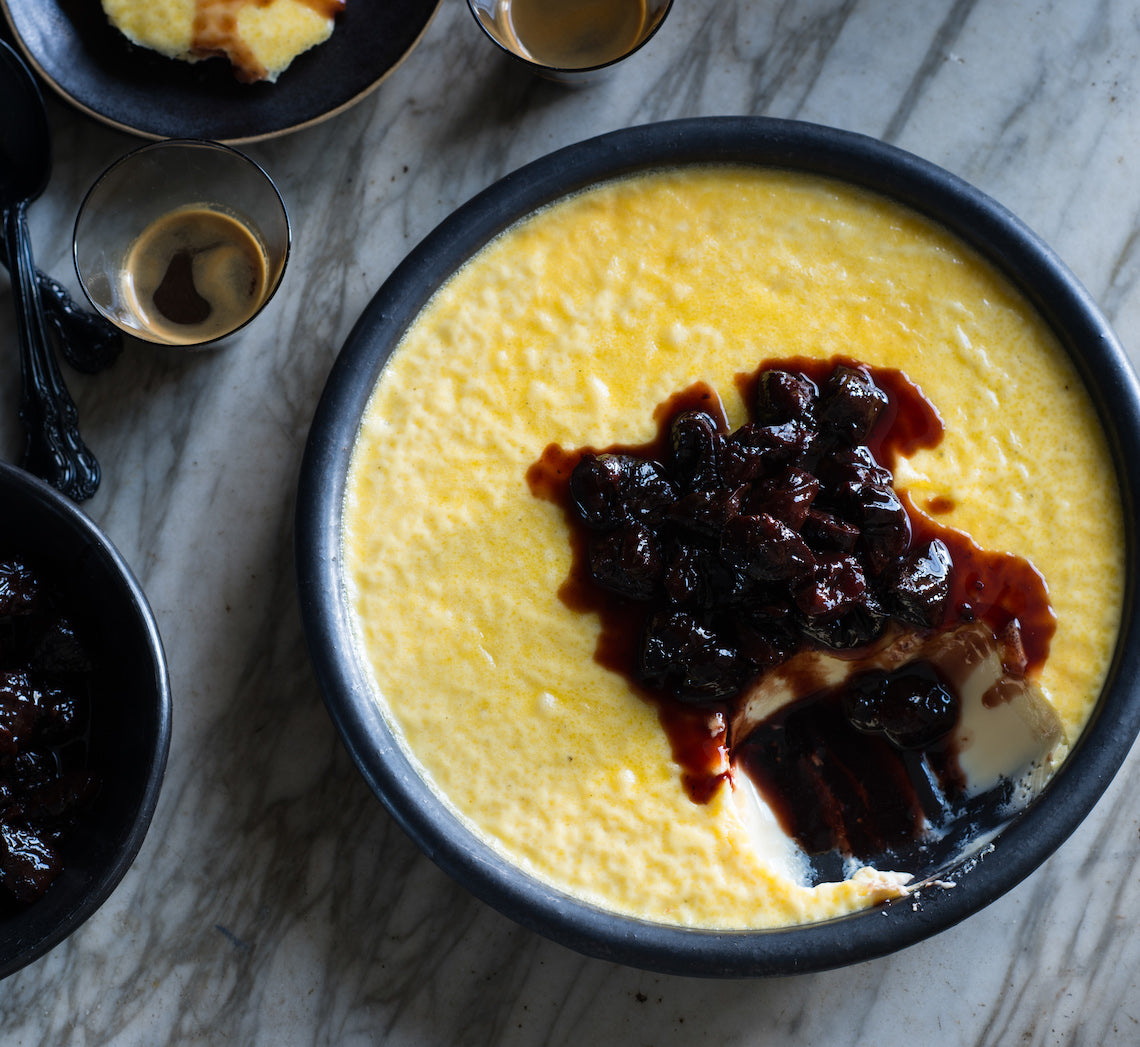
Prep 20min (+1day macerating, 30min cooling and 1-2hr chilling time)Bake 40-50minMakes 10-12 serves
The secret to a silky smooth baked custard is the balance of eggs to milk and cream and gentle baking. This velvety one is teamed with macerated prunes for a memorable dessert.
Ingredients
Baked custard
500ml (2 cups/17fl oz) milk
500ml (2 cups/17fl oz) pouring cream
1 vanilla bean, split lengthways and seeds scraped, or 1½ teaspoons vanilla bean paste
5 x 60g/2oz eggs, at room temperature
110g (½ cup/4oz) caster sugar
Macerated prunes
250ml (1 cup/9fl oz) port
400g (14oz) prunes, pitted and halved
Method
- To make the Macerated Prunes, heat the port in a small saucepan over medium heat until hot but not simmering. Pour over the prunes in a heatproof bowl, cover and set aside to macerate for at least 1 day.
- Preheat oven to 160°C/315°F (140°C/285°F fan-forced). Brush a shallow 2-litre (8-cup/3.5-pt) ovenproof dish with the melted butter to lightly grease and place in a large roasting pan or ovenproof dish.
- Combine the milk, cream and vanilla bean and seeds in a medium saucepan and heat over low heat until almost simmering. Use a balloon whisk to whisk the eggs and sugar until well combined. Gradually whisk in the hot milk mixture. Strain the custard into a large jug and then pour into the greased dish. Add enough boiling water to the roasting pan to reach halfway up the sides of the dish.
- Bake in preheated oven for 40-50 minutes (see Baker’s tips) or until set on top but the custard still wobbles slightly when the dish is shaken gently. Remove from the oven and transfer to a wire rack to cool for 30 minutes. Place the custard in the fridge for 1-2 hours or until cooled completely.
- Serve the custard in spoonfuls accompanied by the macerated prunes with some of the port.
Baker's Tips
- The baking time will depend on the depth of your dish – the deeper the dish the longer the baking time will be. Always check your custard after 40 minutes though and return to the oven for another 5-10 minutes if it’s not ready.
- This custard will keep covered in the fridge for up to 2 days. Stand at room temperature for 30 minutes before serving.
This recipe is from Anneka's SBS Food online column, Bakeproof: Comforting Custard.
CLICK HERE for more Bakeproof recipes.
Photography by Alan Benson.
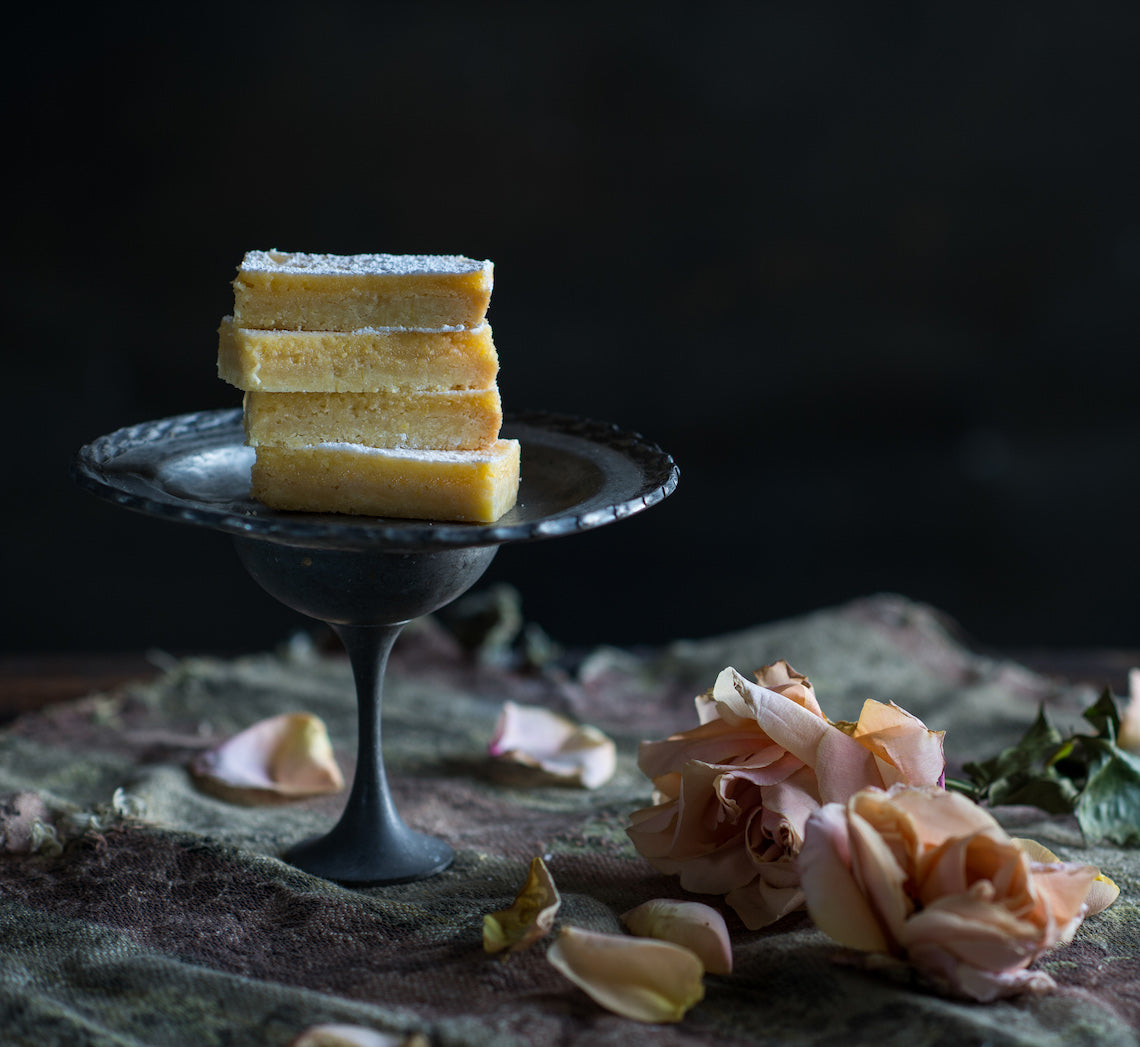
Prep 20min (+1hr cooling time)Bake 1hrMakes about 16
Lemon bars are one of those ‘clever’ slices that combines a simple shortbread-like base and an intensely-tart/sweet lemon topping to create a memorable mouth puckering moment – old-fashioned yet slightly sophisticated, all at the same time.
Ingredients
Base
150g (1 cup) plain flour
50g (¼ cup) caster sugar
150g chilled butter, diced
1 teaspoon natural vanilla essence or extract
Topping
3 eggs, at room temperature
165g (¾ cup) caster sugar
1 tablespoon finely grated lemon rind
125ml (½ cup) strained freshly squeezed lemon juice
2 tablespoons flour
Method
- Preheat oven to 180°C. Grease a 16cm x 26cm (base measurement) slice tin with butter and line the base and sides with one piece of non-stick baking paper, cutting into the corners to fit.
- To make the base, combine the flour, sugar, butter and vanilla in the bowl of a food processor and process until mixture is evenly combined and just starts to come together. Tip mixture into the prepared tin and use your hands to press it evenly over the base. Bake in preheated oven for 20 minutes or until it is golden around the edges.
- To make the topping, use a balloon whisk to whisk together the eggs, sugar and lemon rind and juice until well combined. Add the flour and stir until just combined. Pour the topping over the warm base and return to the oven for 15-20 minutes or until the topping is just set in the center.
- Cool the slice in the tin on a wire rack (this will take about 1 hour). Use the baking paper to lift the slice from the tin. Cut into bars and dust with icing sugar to serve.
Baker's Tips
- These bars will keep in an airtight container in a cool spot (but not in the fridge) for up to 3 days.
This recipe is from Anneka's SBS Food online column, Bakeproof: Citrus.
CLICK HERE for more Bakeproof recipes.
Photography by Alan Benson.
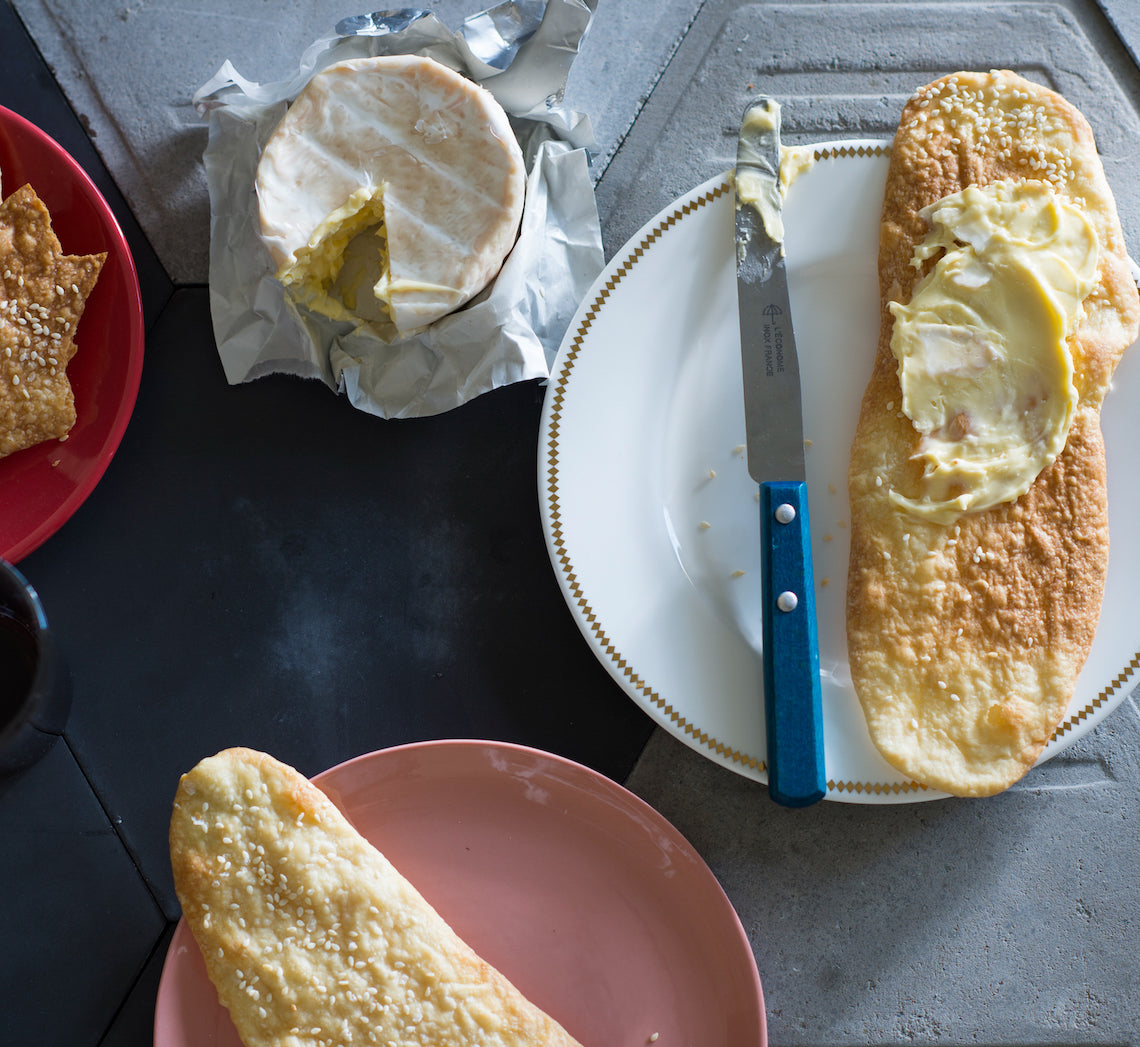
Prep 30min (+20min resting time)Bake 16-18minMakes about 8
Just like the ones you buy, these thin, crisp wafers are the perfect addition to any cheese board. Serve them alongside a soft washed-rind cheese, soft feta, nutty cheddar or any number of dips, such as beetroot or baba ghanoush.
Ingredients
- 225g (1½ cups) plain bread or pizza flour
- 1 teaspoon sea salt, crushed plus extra to sprinkle
- 125ml (½ cup) water
- 60ml (¼ cup) olive oil, plus extra to roll
- 2 teaspoons sesame seeds, to sprinkle
Method
- Preheat oven to 180°C (160°C fan forced). Line 2 large oven trays with non-stick baking paper.
- Combine the flour and salt in a large mixing bowl and make a well in the centre. Combine the water and olive oil, add to the flour mixture and use a wooden spoon and then your hands to mix to a soft dough.
- Turn the dough onto a lightly floured surface and knead for 1 minute or until smooth, elastic and bounces back when you press your finger into it. Wrap the dough in plastic wrap and set aside for 20 minutes to rest.
- Divide the dough into 8 portions and roll each in a little extra olive oil to coat lightly. Use your hands to flatten a portion into a rough rectangle and then use a rolling pin to roll out thinly and evenly into a large rectangle about 2mm thick (see Baker’s tip). Place on the lined trays. Repeat with three of the remaining dough portions. Brush the wafers with a little extra olive oil and sprinkle with extra salt and sesame seeds.
- Bake the four wafers in preheated oven for 16-18 minutes, swapping the trays around halfway through baking, or until golden and crisp. Cool on the trays. Repeat with the remaining four dough portions to make eight large wafers in total. Break into smaller pieces to serve.
Baker's Tips
- The more evenly you can roll the dough, the more evenly it will bake.
- These wafers will keep in an airtight container or jar at room temperature for up to 1 week
This recipe is from Anneka's SBS Food online column, Bakeproof: Savoury Crackers.
CLICK HERE for more Bakeproof recipes.
Photography by Benito Martin.
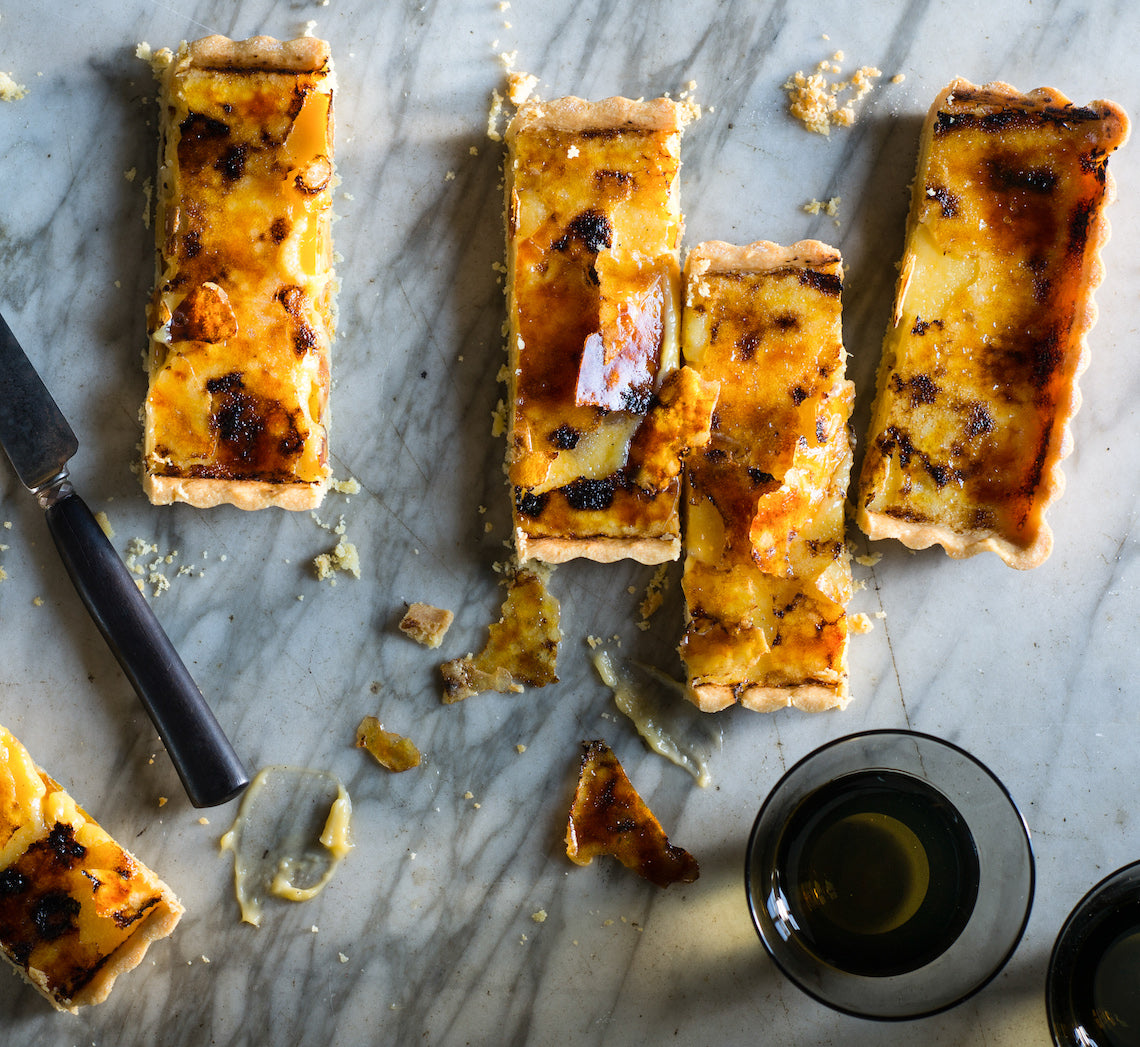
Prep 25min (1hr cooling time)Bake 60-65minMakes 8 serves
Spiked with chunks of crystalised ginger this luscious crème brûlée custard makes a divine tart filling. I have to confess, that this is one of my all-time favourite desserts!
Ingredients
1 quantity sweet shortcrust pastry
50g ( 1¾oz) crystalised ginger, cut into small pieces (about 8mm/3/8in)
2 tablespoons cater sugar, to sprinkle
Crème Brûlée Filling
250ml (1 cup/9fl oz) pouring cream
1 vanilla bean, split lengthways and seeds scraped
3 egg yolks, at room temperature
55g (¼ cup/2oz) caster sugar
Method
- Preheat oven to 200°C/400°F (180°C/350°F fan-forced). Use a lightly floured rolling pin to roll out the pastry on a lightly floured bench top to a rectangle about 3mm/ ⅛in thick. Carefully drape the pastry loosely around the rolling pin. Place it over an ungreased 2.5cm/1in deep, 34.5cm x 11.5cm (13½in x 4½in), base measurement, tart tin with a removable base and then unroll the pastry being careful not to stretch it. Gently lift the edge of the pastry and ease it into the tart tin to line the base and sides and settle it into the corners. Use your fingertips to press it gently into the corners without stretching it. Then, working around the tin, press the pastry into the side using your thumb or finger. Roll the rolling pin over the top of the tart tin to trim any overhanging pastry.
- Place the tart tin on an oven tray. Prick the pastry base with a fork about 12 times. Line the pastry case with crumpled baking paper or foil and fill with pastry weights, or raw rice, making sure they press into the corners. Bake in preheated oven for 20 minutes.
- Remove the pastry case from oven and use the paper or foil to carefully lift the weights out of the case. Return to the oven and bake for a further 20 minutes or until golden and cooked through.
- Meanwhile to make the Crème Brûlée Filling, combine the cream and vanilla bean and seeds in a medium saucepan and bring almost to a simmer over medium heat. Remove from heat and set aside. Use a balloon whisk to whisk together the egg yolks and sugar until well combined. Gradually stir in the hot cream mixture (don’t over-mix – you don’t want it to be frothy). Strain the custard into a heatproof jug.
- Remove the tart case from the oven and reduce the oven temperature to 160°C/315°F (140°C/285°F fan-forced). Sprinkle the base evenly with the ginger and then pour the warm custard immediately into the hot tart case. Carefully return to the oven and bake for a further 20-25 minutes or until the custard is just set and it still wobbles slightly in the centre when the tin is shaken gently.
- Remove the tart from the oven and set aside on a wire rack for at least 1 hour or until cooled to room temperature.
- To serve, sprinkle the top of the tart evenly with the sugar and use a blowtorch to caramelise the sugar until a deep golden. Stand for 5 minutes for the toffee to set before serving.
Baker's Tips
- This tart will keep in an airtight container in the fridge for up to 2 days. Stand at room temperature for 30-60 minutes to bring back to room temperature before serving. The pastry will soften slightly on storing.
This recipe is from Anneka's SBS Food online column, Bakeproof: Comforting Custard.
CLICK HERE for more Bakeproof recipes.
Photography by Alan Benson.






